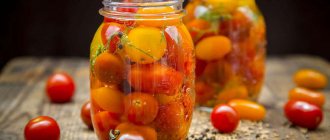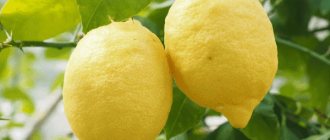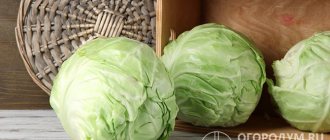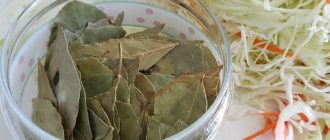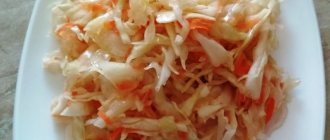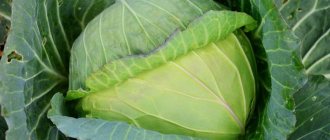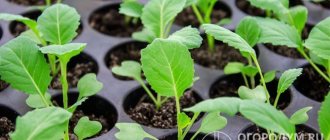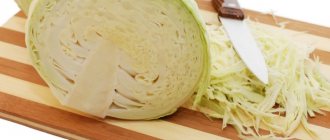How to properly ferment cabbage with heads of cabbage: step-by-step instructions and recipe options
Sauerkraut is one of the simplest and most common ways to process vegetables for long-term (more than six months) storage.
Cabbage is fermented from the second half of September to mid-November; during this period, late and mid-late varieties ripen en masse. Early varieties of vegetables are not suitable for fermentation, as they have loose heads of cabbage and are green in color; they also contain less sugar, so they ferment less well. In total, in traditional Slavic cuisine there are several types of sauerkraut: chopped, shredded and cabbage. The article will tell you how to ferment cabbage into heads, how to store it and what to use it with.
Sauerkraut for the winter in jars - photo recipe step by step
Sauerkraut contains many times more vitamins and nutrients than fresh vegetables. At the same time, the fermentation process is not at all complicated, the main thing is to follow the instructions exactly, then you will get a juicy and crispy preparation for the whole year.
For fermentation, you need to take only dense, late varieties of cabbage and use wooden or enamel dishes.
Your rating: ( 13 ratings, average: 5.00 out of 5)
Cooking time: 1 hour 0 minutes
Quantity: 1 serving
Advantages and disadvantages of fork fermentation
The disadvantage of salting whole cabbage for the winter is that the unchopped vegetable takes up a lot of space. To salt cabbage with forks, you will need not only a separate room, but also special containers, for example, barrels. Shredded cabbage can be fermented in ordinary three-liter jars and stored in the refrigerator or on the balcony.
The advantages include the simplicity of the process, as well as a large number of recipe variations: such cabbage is fermented with cumin, horseradish, apples, coriander, carrots, beets and other vegetables and spices, which impart their beneficial properties and taste to the vegetable. Sauerkraut in forks is a real superfood containing vitamins and minerals that are essential for the human body.
Table “Chemical composition of sauerkraut”
Delicious winter cabbage sauerkraut in brine
Cabbage sauerkraut in brine for the winter always turns out tasty and attractive in appearance. It is thanks to the brine that the appetizer remains juicy and does not dry out, and the carrots make it brighter. You can store in the refrigerator and ferment as needed.
Ingredients:
- Cabbage – 1 head;
- Carrots – 1 pc.;
- Black peppercorns – 12-14 pcs.;
- Bay leaf – 3 pcs.;
- For 1 liter of brine:
- Rock salt – 1 tbsp. l.;
- Sugar – 1 tbsp. l.
Cooking instructions:
- Shred the cabbage head at your discretion. Grate the carrots on a coarse grater or cut into thin strips. Mix the products in one bowl. Add black peppercorns there.
- We also put a bay leaf in a common bowl. Mix thoroughly and set aside.
- Pour granulated sugar and salt into filtered or spring water and stir until the ingredients dissolve. Pour the brine into the cabbage, cover with a plate and place something heavy on it. Send to a warm place for 3-4 days.
- Then drain the liquid, put the sauerkraut in a jar and fill it with marinade. Close with a nylon lid. When serving, squeeze the cabbage well, pour in sunflower oil and sprinkle onions on top.
How to ferment cabbage with heads of cabbage
As already mentioned, it is customary to ferment cabbage in the autumn, when the main crop suitable for harvesting ripens. The list of ingredients required for sourdough includes:
- cabbage - 10 kg;
- carrots - 300 g (3% of the weight of the main vegetable);
- fine salt - 200-250 g (2-2.5% of the weight of the vegetable);
- apples, lingonberries, cranberries - to taste.
A suitable container for preparing cabbage in forks is a barrel - wooden or plastic. Large metal pans used in food service and large-capacity hard plastic containers are also suitable. All plastic containers must be suitable for storing food products.
In addition, it is recommended to pay attention to what was previously stored in it - if not new barrels, pots and containers are used. For example, the smell of herring that was previously in containers is almost impossible to remove; a product with a fishy smell can be considered spoiled.
Step-by-step instruction:
- The heads of cabbage are cleaned of dirty, rotten and green leaves, and the stalks are cut off.
- Wash, peel and chop the carrots.
- Sprinkle cabbage with salt.
- The bottom of the container is lined with cabbage leaves.
- Green leaves, a plastic napkin and a pressure circle are laid over the entire cabbage, and pressure is placed on the container.
- Brine should appear on the surface of the pressure circle after 24 hours.
- Gas bubbles and foam (signs of fermentation) are removed.
- Every 1-2 days, pierce the workpiece in several places to the bottom with a smooth, pointed stick. The procedure is repeated until gas with a pungent odor stops escaping from the holes.
- After settling the vegetable (by 20-30 cm), remove the oppression, circle, napkin, leaves and browned forks.
- The pressure circle is washed with hot soda solution.
- The napkin is washed in water, then in saline solution.
- With a wrung-out napkin, cover the workpiece in the container again.
- The edges of the napkin are tucked inside the container.
- Cover with a circle and less pressure.
- The brine should reach the edge of the pressure circle, otherwise, increase or add brine.
The preparation in heads of cabbage is considered ready when lactic acid fermentation ends and the vegetable becomes amber-yellow in color and acquires a pleasant aroma. The brine should be cloudy yellow and have a sour-salty taste. The workpiece is ready in approximately 15-20 days.
How to salt cabbage halves
The vegetable is fermented both in heads and in halves. For harvesting, dense heads of late varieties are used.
Ingredients:
- cabbage - 10 kg;
- water - 8 l;
- salt - 320 g.
Preparation:
- The heads of cabbage are cleaned of spoiled and green leaves, and the stalks are cut off.
- The bottom of the container is lined with green leaves.
- Vegetables are placed in containers.
- Green leaves, a napkin and a pressure circle are laid on top of the cabbage, and pressure is placed on top.
- Fill everything with 4% brine (400 g of salt per bucket of water)
- Every 1-2 days the workpiece is pierced to allow gas to escape.
The workpiece is ready in about three weeks.
Cabbage halves with shredded cabbage and carrots
Heads of cabbage and halves are also salted together with chopped cabbage and carrots.
Ingredients:
- cabbage - 10 kg;
- carrots - 300 g;
- salt - 200 g.
Preparation:
- Add carrots to chopped cabbage.
- Grind vegetables with salt.
- Place vegetables in a container in a layer of 30 cm.
- Lay heads of cabbage or halves.
- Place chopped cabbage, etc.
- Cover with green leaves, a napkin, circle and place under pressure.
- They pierce to release gas every 1-2 days until all of it comes out.
Sauerkraut in a barrel: recipe and preparation process
Ingredients for a 30 liter container:
- Capacity 30 l + film;
- White cabbage 25-26 kg;
- Carrots 2-2.5 kg (up to 3 kg);
- Salt at the rate of 150 g-250 g per 10 kg;
- Dill (dry “umbrellas” or seeds) 50 g (can be replaced with caraway seeds or added in equal parts);
- Black peppercorns 50-70 g;
- Bay leaf 15-20 pcs. (we determine visually according to taste).
Why no brine? Sauerkraut without brine goes through all stages of fermentation; it is a perfectly balanced natural product, almost a probiotic due to enzymes. And it's delicious.
Brine is a method of salting, pickling, but not a fermentation process. It is worth adding brine if the cabbage is not juicy, in small volumes for quick cooking.
1. Shred the cabbage.
2. Chop the carrots.
3. Wash the barrel, scald it, dry it, insert a plastic bag and secure it around the edges.
4. In a wide container, mix cabbage, carrots, and spices. Add salt little by little and mash with your hands or a pestle until the cuttings release abundant juice. There should be a lot of juice - it should cover the cabbage completely when compacted.
5. Line the bottom of the container with cabbage leaves and shredded cabbage on top. Knead so that the juice covers completely and another couple of centimeters.
Do you know when is the best time to make sauerkraut? On the days of the new moon!
7. Place the oppression: cover the surface with gauze or cotton cloth, place a wooden circle, and place the oppression on top. There is no wooden circle - any other suitable one.
8. Keep for the first 2-3 days at temperatures up to +18 °C, then move to a cool place. The readiness of cabbage depends on the volume: less fermentation at higher temperatures, and it is ready in 4-7 days.
For large volumes, from 25 to 100 liters, readiness is expected from a week to two or three, withstanding lower temperatures - from +5...+7 °C: with rapid ripening, spoilage of the product is possible.
Sometimes they cannot withstand the “warm” period at all, and the next day the workpiece is sent to a cold cellar.
Important: when storing in a cellar, do not place barrels and other containers on the floor - on a wooden floor, planks 10-15 cm high.
For what? When cooling, the ripening process slows down and can stop in a cold cellar.
And what to do with it next is another story.
Every few days it is important to check the cabbage, prick it in the center, at the edges - long, efficiently, to the very bottom.
Recipe Variations
Among the variety of recipes for sauerkraut with forks, let's look at some of the most interesting and delicious ones.
With pickled mushrooms
White cabbage with pickled mushrooms is often found in Slavic cuisine. To do this, the heads of cabbage are fermented in the usual way with carrots, which was described above. After fermentation is complete, the vegetable is placed in a small container and mixed with chopped pickled mushrooms.
Ingredients:
- cabbage - 10 kg;
- carrots - 300 g;
- salt - 160 g;
- pickled mushrooms - 900 g.
With parsnips
The heads of cabbage are fermented according to the classic recipe with carrots, and parsnips are added after fermentation is complete.
Ingredients:
- cabbage - 10 kg;
- carrots - 600 g;
- fresh parsnips - 300 g;
- salt - 200 g.
Heads of cabbage with beets
Forks are fermented with beets, peeled and blanched for 2-3 minutes in boiling water. Forks of cabbage are placed in containers and topped with chopped beets. Pickling occurs according to the same principle as usual.
Ingredients:
- cabbage - 10 kg;
- red beets - 400 g;
- salt - 170 g.
Heads of cabbage with cucumbers
Not only spices, berries, fresh vegetables and fruits are added to cabbage, but also pickles. The cucumbers turn out a little compressed, but crispy, with the smell of cabbage. The preparation acquires the sharpness of cucumbers and a slight sourness.
Ingredients:
- cabbage - 10 kg;
- carrots - 330 g;
- strong pickled cucumbers - 7-8 kg.
Preparation:
Forks, chopped carrots and pickles are placed in a container lined with cabbage leaves in layers of 20-30 cm. The compaction is completed with cabbage, it is covered with sheets, a circle is placed and placed under pressure for 30 days.
"Provencal"
Provencal cabbage is prepared from pickled forks, to which pickled apples, pickled stone fruits, grapes, cranberries, lingonberries, sugar and vegetable oil are added. Provencal cabbage is prepared according to various recipes.
Ingredients:
- cabbage - 5 kg;
- sugar - 3.7 kg;
- vegetable oil - 700 g;
- mustard powder - 1 g;
- cranberries or lingonberries - 450 g;
- pickled fruits - 450 g;
- pickled grapes - 450 g;
- soaked apples - 500 g;
- marinade left over from stone fruits - 350 g.
Preparation:
- The vegetable is chopped.
- Add sugar and mustard to it.
- Apples are cut into eight pieces.
- Vegetable oil is filtered through cheesecloth.
- The mixture of cabbage, berries, stone fruits and apples is placed in a container, but not compacted.
- Pour in the strained marinade.
- Store at temperatures from 0 to +5°C for 10 days.
How to use
Pickled forks are used both as an independent dish and as part of complex recipes. The finished product is not placed on the table entirely; it must be cut or chopped. Pickled vegetables are an excellent appetizer for alcoholic drinks and a traditional side dish . In post-Soviet canteens, for example, you can find shredded preparation, pickled in heads of cabbage, on a plate with mashed potatoes and cutlets.
The vegetable is also used as an independent dish: it is poured with oil, seasoned with pepper, onion and garlic. For a beautiful presentation at the holiday table, shredded vegetables are decorated with herbs, pomegranate seeds, grapes, lemon and cranberries.
The fermented barrel vegetable is found in classic borscht and cabbage soup, it is stewed with meat, and it is used to stuff fish for subsequent baking. Also, the fermented product is suitable for filling pies and pies, it is put in salads, and the brine from under the heads of cabbage is suitable as a cure for a hangover.
Terms and conditions of storage
Any pickled forks, regardless of the recipe, should be stored in a cool place at a temperature from 0 °C to +4 °C. This way the vegetable will retain its taste and beneficial properties for up to eight months. At temperatures from +5 to +8°C, the product is stored for no more than two weeks, then it begins to oxidize.
Cold will destroy vitamin C and spoil the taste, so freezing the heads of cabbage is not recommended.
An important condition for preserving the product is the presence of brine. It should cover the workpiece completely.
How to pickle cabbage at home - delicious and quick recipes with photos
Often during the cold season, you really want not just lunch and dinner, but something more appetizing and spicy. This is where the questions arise: how to salt cabbage, how to maintain its crunchiness and give it a piquant taste.
What is the difference between pickling and sauerkraut?
Sourdough appeared in ancient times as the simplest way to preserve food, when people did not yet know how to extract salt. However, there is a fundamental difference between pickling and sourdough, which manifests itself not only in the preparation method, but also in taste.
Salting will be a more effective and reliable way to preserve cabbage, while pickling involves constantly keeping the product in a cool place after the fermentation process is completed due to the presence of bacteria in the cabbage. Salting cabbage is much easier than fermenting it. However, in order to brighten up the taste, salted cabbage necessarily requires some additives: dill, bay leaf, carrots, etc. Sauerkraut does not require this and can even be called a healthy product due to the lack of salt content, which, as is known, has the property of retaining moisture.
Selection and preparation of ingredients
You need to prepare sauerkraut from the right raw materials. The first and most important rule is that the product must be fresh and of high quality. It is best to use crops grown in your own garden for these purposes, but if this is not possible, you should try to purchase vegetables on the market, directly from small farmers, and not from resellers.
The fact is that in order to accelerate ripening and more intensive weight gain, the owners of large agricultural holdings treat their fields with nitrogen fertilizers, without caring about maintaining their dosage. As a result, nitrogen accumulates in fruits in the form of nitrates, which in large concentrations are dangerous to health, but even in small concentrations can, at a minimum, cause an unpleasant allergic reaction. In a salted vegetable, the content of these substances, however, decreases significantly (to be more precise, some of them are transformed first into nitrites, then into ammonia), but they still do not disappear completely.
Further, only mid-season and late varieties of vegetables should be used for pickling , and this universal rule applies not only to cabbage. Early fruits are very good for quickly satisfying the body's need for vitamins after a long winter, but the nutrients in such products are still much less than in those that have ripened for the required period. And the price of early-ripening vegetables and fruits is too high to use them as raw materials for preparations.
The third rule is that it is best to ferment with white forks . They contain more sugar than green-leaf varieties, and sweetness is important for good fermentation, since it provides the main food for the bacteria that support this process.
More “advanced” housewives select very specific varieties of cabbage for fermentation, knowing well that even with strict adherence to technology and recipes, the taste of the finished product directly depends on the specific type of raw material.
Both shredded and whole-piece sauerkraut, as practice shows, are best prepared from varieties and hybrids such as:
- Atria F1;
- Snow White;
- Belarusian;
- Grandslam F1;
- Dobrovodskaya;
- Geneva F1;
- Stone head;
- Kvashenka;
- Mara;
- Hope;
- Present;
- Polar;
- Glory 1305;
- Fighter F1;
- Salting miracle F1;
- Anniversary F1.
Recipes for pickling cabbage with forks for the winter
Salting cabbage with a single fork is convenient because it is suitable for quickly processing a large harvest . However, in this case it is better to use a bulk container - a large pan, barrel or bucket - as a salt (the container in which fermentation will be carried out). It is difficult to fit a whole head of cabbage into a jar, much less several forks, so this container is not suitable for implementing the idea, however, some housewives manage to salt cabbage using a similar method in standard glass containers with a volume of 3 liters or more.
Many people believe that the best container for fermenting vegetables is an oak barrel, but in reality this is not entirely true . Oak is a classic and irreplaceable material for making wines and cognacs, but linden or birch are much more suitable for pickling - such barrels or tubs are cheaper and do not add an unusual color and “tannic” taste to the finished dish. The technology for preparing a dish may differ slightly depending on the utensils used and other criteria, so below are the three most successful recipes that can be adopted.
How to pickle cabbage with forks for the winter with different additives?
Many housewives pickle cabbage for the winter so that they can serve it as an independent salad, as well as use it for a variety of dishes. In most cases, the vegetable is finely chopped and then poured with marinade, but you can greatly simplify your task and cook whole heads of cabbage.
The processes are very similar, but it is important to have an appropriately sized container. For example, it could be a barrel, a large saucepan or a plastic bucket. Let's look at a few proven recipes.
How to pickle cabbage at home - quick and tasty recipes for the winter
It's time to prepare cabbage for the winter. This is a rather messy matter, but it is necessary. After all, this one will be easy to use in any dish: first, second or salads. But not only that. Since this is a wonderful appetizer both on the dinner table and on the holiday table. The thing is that as soon as you add oil and onions to salted cabbage, you will get a salad rich in vitamins.
Yes, it is a large amount of vitamins that we need so much in cold weather. And there are a lot of them in it. For those who don’t know, I’ll tell you which ones exactly. These are vitamins A, B, C, P, K and more. It also contains calcium, fluorine, potassium and sulfur. And I’m generally silent about the fact that it consists of fiber, which is so necessary for our intestines.
In previous articles, attention was already paid to cabbage and pickled cabbage for the winter, as well as how to cook it in Korean. But I would like to dwell on this in more detail. After all, there are so many recipes and they all differ from each other. Although the preparation method is almost identical, the compositions differ. The whole point is that someone likes to add some spices. And there are those who can’t stand them. What type of person are you?
If you don't know the answer to this question, make a jar of each recipe and label them somehow. When you taste it in winter, you will definitely answer this question. And you’ve probably already decided on the method of preparing cabbage. Now let's get started!
How to salt cabbage at home?
This is a fairly classic way of preparing cabbage. Since it contains the most minimal set of products. And as far as I know, many people used to do this not only at home. but also in different canteens. Therefore, this is a long-tested recipe not only by me, but also by most housewives.
Ingredients:
- White cabbage - 1 fork (medium size);
- Carrots – 2 pcs.;
- Salt – 4 tsp.
Preparation:
1. Remove the top two to three leaves from the head of cabbage. We won't need them as they are usually quite dirty and scratched. The fork itself can be rinsed under running water and dried with a paper or kitchen towel.
Next, cut it into 2 – 4 parts. This is so that it is convenient for us to chop it. This can be done using a special shredder. If you don’t have one, then use your most common and favorite knife. Try to keep the straw as thin as possible. We put the finished product in a large container, but I will do everything on the countertop.
The stalk cannot be used, since it is in it that all harmful substances are collected.
2. Wash and peel the carrots. Three it on a coarse grater immediately into the white cabbage.
At this point you can adjust the amount of carrots. Some people like it a lot, while others prefer less.
3. Now mix thoroughly and knead a little with your hands. Then add salt and continue the process. Only now you need to crush it harder to release the juice.
How to pickle cabbage with forks for the winter?
This method of preparing this vegetable is especially popular in Bulgaria. Various snacks are prepared from whole leaves, for example, cabbage rolls or Korean salads. The prepared ingredients are designed for a 100 liter container.
- 50 kg cabbage;
- 2.5 kg of coarse sea salt;
- cold water.
In addition, you need to take a 1.5 m long plastic hose. You can include other vegetables and spices in this recipe for taste.
- To pickle the forks, the heads of cabbage must be prepared by removing the leaves from them and removing the stalk.
- Make a cross-shaped cut on the fork.
- Fill the hole where the dense part of the vegetable was with salt.
- Place the cabbage heads tightly into the prepared container, having first lowered one edge to the bottom, and the other should stick out on the surface. If you wish, you can add a couple of onions, quince or horseradish root. These ingredients will give the vegetable an original taste and aroma.
- Place the remaining salt in the water, mix well until completely dissolved, and then pour the brine into the container. The liquid should cover the vegetables.
- Place a weight on top so that the heads of cabbage do not float up.
- Over the course of 5 days, it is necessary to mix the brine, for which you will need a hose, which was first fixed in the container.
- Remove the pressure, and then blow strongly into the free end of the hose about 10 times. This will be enough to mix the brine.
- Over the course of 3 weeks, the process should be repeated a couple of times.
- After a couple of months, the cabbage is considered ready.
- A white film will appear on the surface of the liquid, which is one of the signals of readiness.
- Using a slotted spoon, remove it. The process must take place in a cold room.
Salting cabbage for the winter with forks in a barrel
The ideal vessel for this procedure is an oak barrel. Forks prepared according to this recipe are not only tasty, but also very healthy. Thanks to the fact that whole heads of cabbage are salted, they can be preserved until spring and enjoyed in delicious dishes all winter long. By the way, cooking vegetables in a barrel was common in the pre-revolutionary era.
First you need to prepare the container. Take the barrel and rinse it thoroughly with a solution of soda and boiling water. After this, it must be completely filled with water and left for 7 days. This is necessary so that the wood swells and subsequently does not absorb the solution. To pickle cabbage with forks, it is recommended to use late varieties of vegetables. Also prepare carrots, tomatoes and sweet peppers. If you want to give the vegetable a beautiful color, add beets.
- To begin, remove the outer leaves from the forks so that you are left with a smooth, dense head of cabbage. By the way, you don’t have to throw away the cut leaves, because they can fill the voids in the top row and after a few weeks they are considered ready.
- Remove the stalk using a sharp knife. Thanks to this, the salting process will proceed evenly.
- Place the vegetables in the prepared barrel, filling the voids with large pieces of carrots, tomatoes and peppers.
- These vegetables will make the taste of the product even more original.
- We will salt in brine, to prepare which combine 10 liters of purified water and 400 g of salt.
- Pour the liquid into the barrel, place the leaves in the voids and cover the top with a piece of linen cloth.
- Place the cross and press it down with a load, for example, a stone.
- Every week, you need to take out the fabric and wash it together with the circle in water, removing any mold that has formed. In a couple of months everything will be ready.
Pickling cabbage
Now it's time to pickle the cabbage. I love it very, very much, but I just don’t know how to salt cabbage. Well, it doesn’t work out at all. So my neighbor Comrade Raya taught me this recipe. I will be salting for the third winter already.
- 24816
- 168
- 23
Cabbage salad
We used to make sauerkraut with our whole family in the fall. We had a tub and a little tub. But the problem is, there is nowhere to store cabbage. It freezes on the balcony and then becomes tasteless. It turns sour in the refrigerator. And we love cabbage very much. The problem was solved when I saw this recipe in one of the culinary newspapers about 7-8 years ago. Since then I have been making cabbage only according to this recipe. Fortunately, now you can buy it all winter, not like in Soviet times. Incredibly delicious. Many of my friends, having tried it from me, took the recipe into service. and I received a sea of gratitude from them. Try it, and I'm sure you won't resist. As my husband says every time he starts eating this cabbage: “After trying it once, I eat it now!”
- 816296
- 11655
- 1387
Pickling in a jar
There are probably no people who don’t salt cabbage. They wouldn't love her. And on our website there are recipes on how to quickly pickle at home. Can I share my homemade pickles too?
- 75799
- 459
- 116
The same Georgian cabbage
I reviewed all similar recipes here. This is definitely not the case. This is probably a recipe from that series when real secrets are passed on only to loved ones. More than 25 years ago, my mother-in-law, who lived in Georgia all her life, taught me how to cook cabbage this way. I declare with complete responsibility: pickles simply don’t get any tastier than this cabbage! And most importantly, everything is very simple and there is nothing superfluous in the ingredients: no oil, vinegar, etc. Prepares quickly and eats even faster. True, I’ve been cooking “by eye” all my life.
- 537091
- 5855
- 781
How to salt cauliflower with forks?
You can cook not only white cabbages, but also colored forks, which also turn out very tasty. Individual inflorescences will be an excellent basis, for example, for Korean salads.
- 2 forks cauliflower;
- 0.5 kg carrots;
- 5 bay leaves;
- 6 peppercorns;
- the same number of cloves of garlic.
To make 1 liter of brine, you will need:
- 1 tbsp. spoon with a heap of salt;
- a little less than 1 tbsp. spoons of sugar.
- Pickling begins with preparing the vegetable: take a good look at the forks, as they should be firm, white and without stains. Otherwise, they are considered unsuitable for pickling.
- Rinse them in water, then soak them for a couple of hours to remove insects. It is best to remove legs that are too hard.
- The next step is to lower the forks for 2 minutes. into boiling water, and then transfer to cold water. It is important not to overcook the vegetable, as it will become soft and unsuitable for further processing.
- Grind the peeled carrots on a regular Korean grater.
- To make the brine, dissolve salt and sugar in water.
- After this, put the liquid on the stove and boil. Place forks in the pan, add carrots, pieces of garlic, bay leaves and peppercorns, and then pour cooled brine over them.
- Place pressure on top and leave for 2 days at room temperature.
- After this, move the container to a cool place, and after 4-5 days the cabbage will be ready. The vegetable should be stored in the refrigerator.
Sauerkraut for the winter with apples or cranberries
Sauerkraut with apples or cranberries is an incredibly tasty, crispy and healthy snack. Even a novice cook can handle its preparation - it’s so simple. The main thing is to keep the cabbage in the jar for at least four days, otherwise it will not have time to reach the desired state.
Ingredients:
- White cabbage – 5 kg;
- Carrots – 3-4 pcs.;
- Cranberries – 200 g;
- Green apple – 3 pcs.;
- Bay leaf;
- Black and allspice peppercorns;
- Carnation;
- Salt – 5 tbsp. l.;
- Sugar – 3 tbsp. l.
Cooking instructions:
- We chop the cabbage into strips, and grate the carrots on a coarse grater, preferably in long strips. We peel the apples from seeds and membranes, and then cut them into slices.
- Transfer the carrots in small portions to the cabbage, add salt and sugar. Mix well, rubbing with your hands. Place cabbage leaves, bay leaves, pepper and cloves at the bottom of a clean three-liter jar.
- We pack the cabbage tightly into half the jar, apple slices and a handful of cranberries. Add spices and fill the jar to the top with the remaining vegetables. Cover the filled jars with a towel and leave them like that for a day.
- Every other day, if necessary, pour warm boiled water into the jars so that the liquid is above the surface of the cabbage. Let it ferment for 3 days and pierce it with a skewer from time to time to release gases.
- When the cabbage becomes sour enough, put it in a cool place. Relatives and guests will be absolutely delighted with such a chic snack.
Recipe for fork-sauerkraut with apples
Another option for preparing a vegetable, which thanks to apples turns out to be aromatic. In addition, salted fruits also turn out very tasty. Most often, this recipe is used by people who want to cook tasty and juicy cabbage rolls in winter.
- 3 heads of cabbage;
- 1 kg apples;
- salt, which should be taken on the basis that there should be 90 g per 1 liter. In general, you will need about 5 liters of water.
- Cabbage prepared for this recipe should be cleaned of old leaves and various stains.
- Using a sharp knife, remove the stalks. Take a large container, pour warm water into it and dissolve the salt. Stir well until the salt dissolves.
- Place the heads of cabbage and apples tightly in a container with brine.
- Cover the top with a layer of gauze and place pressure, for example, it could be a bottle of water. Leave for 5 days at room temperature.
- After the time has passed, rinse the gauze in running water to remove mold, and also turn the heads of cabbage over. To make the preparation crispy, it is recommended to add a couple of corn cobs.
- Place the gauze again and apply pressure. After this, move everything to a cool place for a month.
As you can see, there is nothing complicated about sauerkraut and anyone can cope with this process. Be sure to use the recipes provided to get a tasty and healthy dish for your family.
Sources:
https://agronom.expert/posadka/ogorod/kapustnye/kapusta/zakvasit-kochanami.html https://fermer.blog/bok/recepty-i-zagotovki/8208-kak-zasolit-kapustu-vilkami-na-zimu .html https://myusli.ru/recepty/kapusta-vilkami-na-zimu


